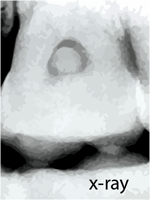Pulp stones
Pulp stones are tough, bone similar structure that develop in the pulp of a tooth, possibly within the tooth crown or perhaps within the tooth root canal. Pulp stones range in dimensions significantly or even they fill up the pulp chamber or perhaps a segment of the tooth root canals. Pulp stones can be found like individual or perhaps multiple bony structures within the pulp or they could be connected to the surfaces of the pulp chamber. The majority seem to be connected, when the removed tooth is analyzed under a microscope. Sometimes, they may have been located in tooth which have not at this point grown in.
Pulp stones are very frequent, manifesting in up to ninety percent of individuals between the fifty and seventy years. Their occurrence appears to raise with age. The elements associated with the progression of the pulp stones are mostly unidentified. It really is not identified exactly what leads to pulp stones, however they are not uncomfortable and usually display no signs or troubles, besides sometimes getting in the way throughout root canal treatment. Pulp stones are separate calcifications because they are between modifications which include a lot more diffuse pulp calcifications for example calcification occurring in degenerated or necrotic tissue.
Pulp stones could be found easily within the pulp tissue or perhaps be connected to or inserted in dentine. Two forms of calcified components in the dental pulp are identified, denticles holding a main cavity filled with epithelial remnants wrapped by cells forming the outer surface of dental pulp, as well as pulp stones that is small degenerative masses of calcified tissues. One tooth could have from one to ten or maybe more pulp stones, with dimensions ranging from tiny elements to substantial masses which close up the pulp area.
Pulp stones more frequently take place in the coronal area then in the radicular pulp. Pulp stones are observed in individuals with systemic or perhaps hereditary disorders for example dentin dysplasia, hereditary opalescent dentin as well as in some syndromes for example Van der Woude.
Pulp stones could be structurally classified and determined by position. Structurally, you can find true and false pulp stones, another form, amorphous pulp stones, is much more unusual in form compared to false pulp stones, manifesting in near connection with blood vessels. True pulp stones are constructed with dentine and also coated by odontoblasts, while in contrast false pulp stones are created from degenerating cellular material of the pulp that mineralize.
Such type of mineralization happens progressively, at first cell nests come to be closed by concentrically structured fibres which after that develop into impregnated with mineral salts. Depending on position, pulp stones could be inserted, adherent and totally free. Inserted pulp stones are created in the pulp then again with continuing physiological dentine creation they turn out to be closed within the canal wall structures. These are positioned commonly in the apical part of the tooth root and the occurrence of odontoblasts together with calcified tissue mass similar to dentine may appear on the peripheral element of these types of pulp stones.
Adherent pulp stones tend to be basically significantly less connected to dentine compared to inserted pulp stones, the distinction between adherent pulp stones and embedded pulp stones could be subjective, however adherent pulp stones will never be completely closed by dentine. Adherent pulp stones and embedded pulp stones could impact root canal therapy when they lead to significant occlusion of canals or perhaps are situated at a bend. They could likewise turn out to be dislodged. Free pulp stones are available within the pulp tissue mass because they are the most typically observed form on radiographs.
These are quite typical and range in dimensions from fifty lm in inside diameter to a few millimetres if they may possibly occlude the whole pulp chamber. Pulp stones could be additionally subdivided into the ones with unique concentric laminations as well as the ones without unique laminations. Laminated pulp stones are generally not related to more compact pulp stones, however nonlaminated stones are usually rougher and also could have small pulp stones connected to their surface areas.
There are basically two forms of pulp stones, these kinds that happen to be rounded or ovoid, with smooth exterior together with concentric laminations; and the ones that take absolutely no specific structure, absence laminations with abrasive exterior. They normally are identified on x-ray test, except if these are too little or perhaps are not closely compacted as much as necessary to appear on an x-ray. In cases like this, the pulp stones are identified once we analyze the tooth under a microscope after the tooth is removed.
Since the majority of pulp stones are connected to the interior dentin wall structure, their existence could make root canal treatment quite challenging to extremely difficult. If this is actually the situation and you require root canal treatment to preserve a tooth, we are going to surgically get rid of the pulp stones.
You may also like:
- Causes of Pulp Polyps and Dental Pulp Polyp treatment
A dental pulp polyp or long term hyperplastic pulpitis, is the inflamed pinkish swollen tissue mass. Dental pulp polyp is mostly a result of an neglected cavity in a big tooth.
- 18 Teeth Whitening Home Remedies For Bleaching Teeth At Home
Collection of 18 teeth whitening home remedies for bleaching teeth at home that will boost your tooth shine.
- What is pulp test or pulp vitality test
A pulp test or pulp vitality test is a form of dental treatment. It’s primary purpose is in tooth physical health evaluation, particularly, the dentist seats a tool on the tooth that transmits an electric, high temperature, or perhaps cold current.



